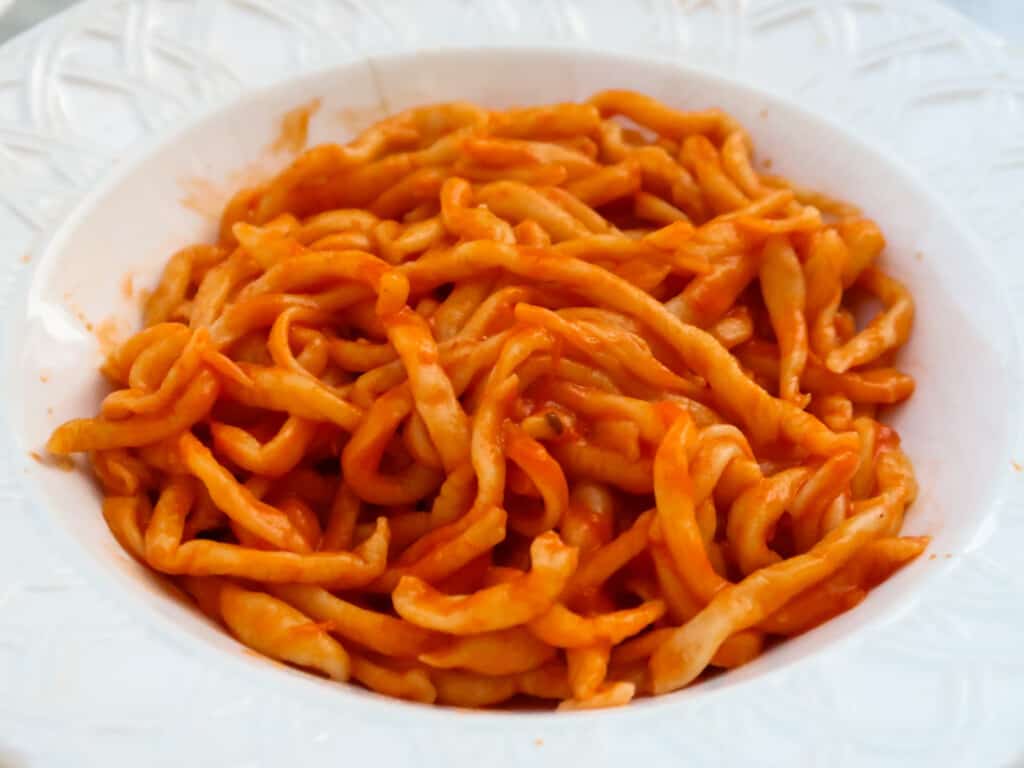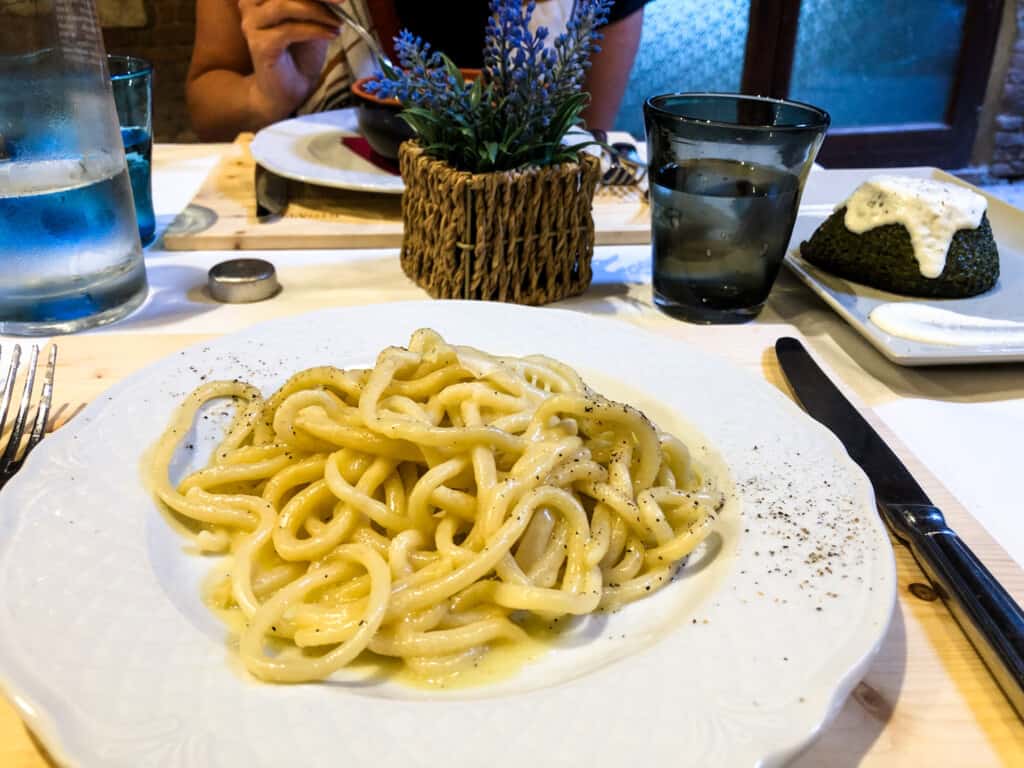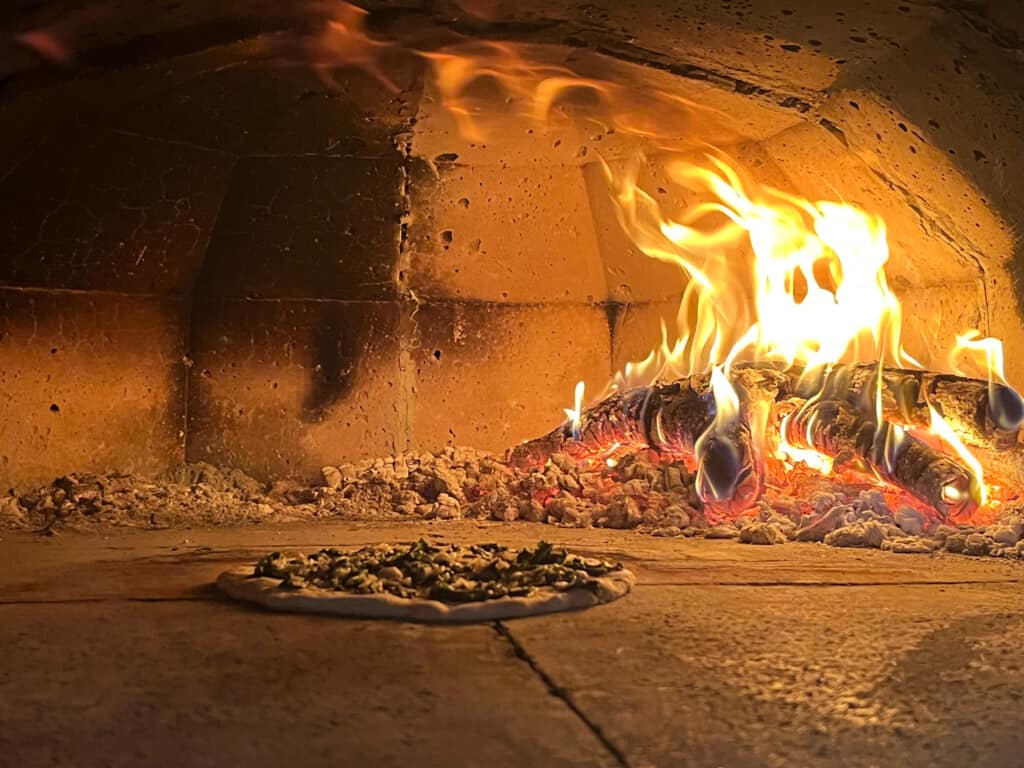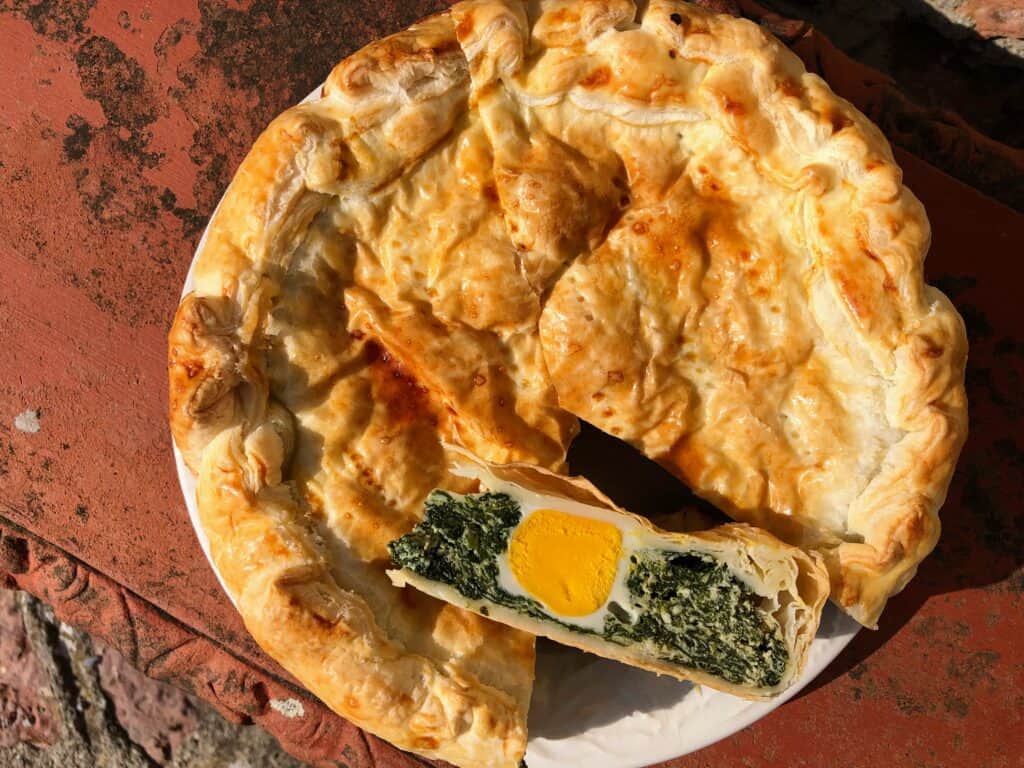Last updated on April 19th, 2024
Thick, hand rolled spaghetti dressed in a garlicky tomato sauce? Yes, please! Homemade Tuscan spaghetti (pici) are easy to make at home and super fun to do with the whole family. But how do you serve them? All’aglione!
In this article, I will explain how to make authentic pici all’aglione and how you can create this aglione sauce at home with ingredients in your pantry!
I’ve been making authentic aglione sauce for over a decade. I first learned from our dear friend and housekeeper, Franca, who lives just down the road from us here in Tuscany. After countless batches of aglione sauce, I am confident in sharing my fool-proof recipe and mybest tips for making the best sauce ever!
Aglione is one of the easiest and most satisfying sauces to whip up, turning any ordinary pasta into a next-level garlic-tomato pasta! Spend just 15 minutes getting the aglione sauce going and then let the magic of time do the rest.
Helpful Tip: If you want to make your own pici pasta to go along with it, get the sauce going and by the time you have finished rolling out the pici pasta, your aglione sauce will be ready.
Jump to Section
How To Pronounce Aglione Sauce
Pici all’aglione is pronounced pee-chee ahl-ahl-yohn-eh in Italian. Pici refers to the type of hand rolled spaghetti pasta that is served with the aglione sauce.
Listen to the pronunciation of pici all’aglione here:
What Is Aglione Sauce?

Aglione is a very garlicky tomato sauce from Tuscany made traditionally with aglione garlic or elephant garlic. Today, however, it’s often made with purple garlic. Aglione sauce is almost exclusively served with pici pasta, a wide hand rolled spaghetti.
Fact: Aglione also refers to the specific variety of garlic grown in Tuscany used to make aglione sauce, known as Aglione della Valdichiana.
This recipe for aglione sauce is from our dearest of housekeepers from just down the road from us. I first learned to make aglione sauce from Ada but have perfected the recipe from our dear housekeeper, Franca, over the years.

Fun Fact: One single clove of aglione della Valdichiana can be as large as a whole clove of regular garlic!
What makes aglione sauce so special is that despite the large amount of garlic in it, the unpleasant garlic taste doesn’t stay in your mouth and it’s easy to digest. Italians hate the stark garlic taste that often stays in one’s mouth after eating it (which is why they cook with whole cloves and remove them later on) but aglione sauce is light and free of stinky-garlic breath.
Aglione Sauce Ingredients

- 1 batch of homemade pici pasta
- 3 ounces purple garlic (6-8 larges cloves) or elephant garlic (3-4 cloves)
- ¼ cup extra virgin olive oil
- ⅓ cup white wine
- 1-28 ounce can whole peeled tomatoes
- 1 teaspoon salt
- a pinch of red pepper flakes, optional
How To Make Aglione Sauce

Peel the garlic, leaving the cloves whole. Lightly smash the cloves with the back of your knife to help release the aroma but do not chop it.

Add the garlic and olive oil to a large skillet and set over low heat. Gently cook until the garlic is fragrant, pale golden and soft, being careful not to brown the garlic (5 minutes or so). The key to this sauce is to cook the garlic very slowly at a low temperature, turning the harsh garlic flavor into a sweet one. Add the red pepper flakes if using and cook for 30 seconds or so.

Add the white wine and let cook for another two minutes until the alcohol has burned off.

Add the canned tomatoes and salt and bring up to a simmer. Gently simmer the aglione sauce, breaking up the tomatoes with the back of your spoon from time to time for about 1 hour. The agione sauce should reduce with the cooking time, resulting in a nice and thick sauce. If for any reason the aglione sauce becomes overly thick and starts sticking to the bottom of the pan, add ¼ cup of water and continue cooking, uncovered.

Season for salt and with an immersion blender, blend until smooth. You can also do this with a blender after the aglione sauce has cooled down.

Cook the pici pasta in a very large pot of salted, boiling water. Save about ½ cup of starchy water before draining.

Drain well and dress with the aglione sauce. If you find the pici all’aglione too dry, add a bit of the pasta cooking water to help loosen things lol up.
Aglione Sauce Substitutions

You can use any kind of garlic. Purple garlic is more flavorful but regular garlic works as well.
Replace the canned whole peeled tomatoes with any kind of canned tomatoes including canned cherry tomatoes or crushed tomatoes.

If you prefer a more rustic sauce, don’t puree it. Just remove the garlic cloves. I learned to puree it from our dear housekeeper, which is how most versions are made in Southern Tuscany. Other times, it’s cooked so long that it breaks down to such an extent that it seems pureed but it’s actually not.
Learn a Trick: Read The Secret Ingredient That Takes Any Pasta Sauce to the Next Level.
How To Serve Aglione Sauce

Aglione is exclusively served with pici pasta in Tuscany without parmesan cheese as a first course for either lunch or dinner. My Florentine husband does put parmesan on his but if you are being served it in a restaurant, don’t expect them to bring you cheese. You can certainly ask for it, of course!
Pici are quite filling because they plump up a fair amount when cooked. When we eat pici in our house, most typically in the fall, winter and spring (it’s a little hot in Tuscany for pici in the summer, IMHO), we will have a side salad or other vegetable. A plate of pici pasta and then a second course is far too much for us!
Make It: Use my Italian family recipe for pici pasta to make your own.
Notes And Tips For Making Aglione Sauce
- The most important step is to slowly soften the garlic without letting it burn. Burnt garlic is awful and your aglione sauce will consequently be so too!
- You can preserve aglione sauce by either freezing or canning it. Consider doubling or tripling the recipe and preserving the aglione sauce in individual portions for one pound of pasta, making for easy weeknight meals.
- You can cook aglione for more or less time, if need be. The longer you cook it, the richer tasting it will be. If you have less time, no worries, you can cook it just the same but may find the garlic taste sticks in your mouth a bit more.
- If you are pinched for time, help break down the canned tomatoes by pouring them into a large bowl and crush them with your hands before adding to the pan.
- Always remember to save a bit of starchy water from when you cook your pasta in case you need to ‘loosen-up’ your aglione sauce a little bit.
How To Store Aglione Sauce

Leftover aglione sauce will store about 5 days in the refrigerator. Alternatively, you can preserve the sauce by freezing or canning it.
If you have dressed pasta with the aglione sauce, keep leftovers in an airtight container in the refrigerator for three days. You can reheat in a fry pin with a bit of olive oil. Many Italians love pici all’aglione risaltati or reheated in a pan because the pici get particularly crispy without turning to mush.
Where To Eat Aglione Sauce
Tuscany, of course! And if we are being specific, you are going to want to head to Celle su Rigo, where pici pasta was first born. Here at Trattoria La Pace, you will find the absolute best pici all’aglione along with pici al ragù (meat sauce). I suggest ordering a portion of each!
You will also find pici all’aglione all throughout Tuscany, especially in the provincia or the province of Siena.
If you are traveling in Southern Tuscany in May, check dates for the Sagra dei pici or pici pasta food festival, held every year in Celle su Rigo for three nights running. This is truly one of the most fun and authentic experiences you can have in Italy!
Good To Know: Pici are also common throughout Umbria but they are referred to as strangozzi.
My best advice for eating really good pici all’aglione is to look for a trattoria off the main drag in any small town or village because they are usually very casual and family run.

Tip: In Southern Tuscany, you can find homemade aglione sauce for sale at small grocers and supermarkets. It’s usually quite good and makes for a great gift or souvenir.
Do you enjoy making and eating Italian pasta? If so, check out these recipes:
Orecchiette Pasta Recipe
Pici Pasta Recipe – How To Make Tuscany’s Hand Rolled Spaghetti
Tagliatelle Recipe + How to Pronounce It
Cacio e Pepe Recipe – Pronounce it and Make it Like an Italian (+ Audio)
Fresh Pomodoro Sauce Recipe – An Italian Summer Tradition
Pomodoro Sauce Recipe – Made With Canned Tomatoes
Creamy Kale Pasta Recipe
Italian Kale Pesto Recipe
Aglione Sauce Recipe
Pappardelle alla Boscaiola Recipe
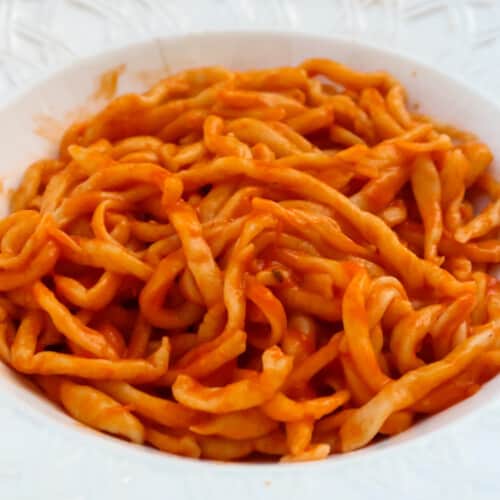
Aglione Sauce
Ingredients
- 1 batch homemade pici pasta
- 3 oz purple garlic (6-8 large cloves) or elephant garlic (3-4 cloves)
- ¼ cup extra virgin olive oil
- ⅓ cup white wine
- 1 28-oz can whole peeled tomatoes
- 1 tsp salt
- pinch red pepper flakes optional
Instructions
- Peel the garlic, leaving the cloves whole. Lightly smash the cloves with the back of your knife to help release the aroma but do not chop it.
- Add the garlic and olive oil to a large skillet and set over low heat. Gently cook until the garlic is fragrant, pale golden and soft, being careful not to brown the garlic (5 minutes or so). The key to this sauce is to cook the garlic very slowly at a low temperature, turning the harsh garlic flavor into a sweet one. Add the red pepper flakes if using and cook for 30 seconds or so.
- Add the white wine and let cook for another two minutes until the alcohol has burned off.
- Add the canned tomatoes and salt and bring up to a simmer. Gently simmer the aglione sauce, breaking up the tomatoes with the back of your spoon from time to time for about 1 hour. The agione sauce should reduce with the cooking time, resulting in a nice and thick sauce. If for any reason the aglione sauce becomes overly thick and starts sticking to the bottom of the pan, add ¼ cup of water and continue cooking, uncovered.
- Season for salt and with an immersion blender, blend until smooth. You can also do this with a blender after the aglione sauce has cooled down.
- Cook the pici pasta in a very large pot of salted, boiling water. Save about ½ cup of starchy water before draining.
- Drain well and dress with the aglione sauce. If you find the pici all’aglione too dry, add a bit of the pasta cooking water to help loosen things lol up.
Notes
- The most important step is to slowly soften the garlic without letting it burn. Burnt garlic is awful and your aglione sauce will consequently be so too!
- You can preserve aglione sauce by either freezing or canning it. Consider doubling or tripling the recipe and preserving the aglione sauce in individual portions for one pound of pasta, making for easy weeknight meals.
- You can cook aglione for more or less time, if need be. The longer you cook it, the richer tasting it will be. If you have less time, no worries, you can cook it just the same but may find the garlic taste sticks in your mouth a bit more.
- If you are pinched for time, help break down the canned tomatoes by pouring them into a large bowl and crush them with your hands before adding to the pan.
- Always remember to save a bit of starchy water from when you cook your pasta in case you need to ‘loosen-up’ your aglione sauce a little bit.
Aglione Sauce FAQ
Aglione is an enormous variety of garlic, sometimes called elephant garlic in English, that grows in Valdichiana in Southern Tuscany.
If you can’t find or make pici, use a thicker spaghetti or bucatini in place of the pici pasta.
